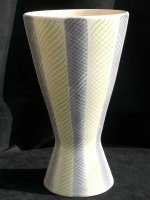Freeform or Contemporary?
Leslie Hayward, author of the definitive Poole Pottery reference book, was behind the counter during viewing at the Cottees auction last week. I asked to see a rather nice contemporary vase from the cabinet. "You got it right, you didn't call it freeform" he said. What did he mean?
 Well, it is noticeable that almost anything from the Alfred Read period is now likely to be described as freeform. In fact, this title should only apply to a limited range of shapes designed by Read and Guy Sydenham in 1956/7 specifically for flower arranging. There were eight different shapes (illustrated on page 100 of the Hayward book), all asymmetric, and all slip cast. They were available in contemporary patterns, but also with traditional floral decoration, in monochrome and in twintone.
Well, it is noticeable that almost anything from the Alfred Read period is now likely to be described as freeform. In fact, this title should only apply to a limited range of shapes designed by Read and Guy Sydenham in 1956/7 specifically for flower arranging. There were eight different shapes (illustrated on page 100 of the Hayward book), all asymmetric, and all slip cast. They were available in contemporary patterns, but also with traditional floral decoration, in monochrome and in twintone.
 The contemporary range, on the other hand, combined mainly symmetrical hand thrown shapes with a fantastic series of abstract geometric patterns, which perfectly captured the spirit of artistic revival that was prevalent in Britain in the mid 1950's. Contemporary patterns, some designed by Ruth Pavely, were also applied to tableware and the freeform shapes.
The contemporary range, on the other hand, combined mainly symmetrical hand thrown shapes with a fantastic series of abstract geometric patterns, which perfectly captured the spirit of artistic revival that was prevalent in Britain in the mid 1950's. Contemporary patterns, some designed by Ruth Pavely, were also applied to tableware and the freeform shapes.
Another related bugbear: I keep seeing "Alfred Rhead". Wrong! Rhead is Charlotte Rhead, who worked for various Staffordshire potteries in the 1930's and '40's. Remember, there's no "H" in Alfred but there is in Charlotte!
 Well, it is noticeable that almost anything from the Alfred Read period is now likely to be described as freeform. In fact, this title should only apply to a limited range of shapes designed by Read and Guy Sydenham in 1956/7 specifically for flower arranging. There were eight different shapes (illustrated on page 100 of the Hayward book), all asymmetric, and all slip cast. They were available in contemporary patterns, but also with traditional floral decoration, in monochrome and in twintone.
Well, it is noticeable that almost anything from the Alfred Read period is now likely to be described as freeform. In fact, this title should only apply to a limited range of shapes designed by Read and Guy Sydenham in 1956/7 specifically for flower arranging. There were eight different shapes (illustrated on page 100 of the Hayward book), all asymmetric, and all slip cast. They were available in contemporary patterns, but also with traditional floral decoration, in monochrome and in twintone. The contemporary range, on the other hand, combined mainly symmetrical hand thrown shapes with a fantastic series of abstract geometric patterns, which perfectly captured the spirit of artistic revival that was prevalent in Britain in the mid 1950's. Contemporary patterns, some designed by Ruth Pavely, were also applied to tableware and the freeform shapes.
The contemporary range, on the other hand, combined mainly symmetrical hand thrown shapes with a fantastic series of abstract geometric patterns, which perfectly captured the spirit of artistic revival that was prevalent in Britain in the mid 1950's. Contemporary patterns, some designed by Ruth Pavely, were also applied to tableware and the freeform shapes.Another related bugbear: I keep seeing "Alfred Rhead". Wrong! Rhead is Charlotte Rhead, who worked for various Staffordshire potteries in the 1930's and '40's. Remember, there's no "H" in Alfred but there is in Charlotte!

0 Comments:
Post a Comment
<< Home